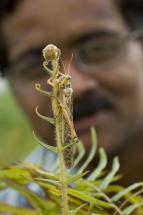In the struggle for survival, plants are often at the mercy of hungry animals – but one fern has turned the tables by using poisonous arsenic to reduce its appeal. This in short is the conclusion of a University of Florida research study published April 24 in the journal New Phytologist.
 Background:
Background: The bioaccumulation of metallic contaminants by plants has been discussed up to now as an evolutionary adaptation of the plants for survival in a contaminated environment. Now researchers from the University of Florida have found another explanation.
New Research results from UFThe UF study showed starving grasshoppers shunned Chinese brake fern – one of several fern species known to store arsenic – when the plants contained large quantities of the toxic heavy metal. It is the first published study showing that arsenic accumulated in plant tissue deters predators.
The grasshoppers somehow sensed the ferns contained arsenic, which is poisonous to insects, said study co-author
Bala Rathinasabapathi, an associate professor with UF’s horticultural sciences department, part of the
Institute of Food and Agricultural Sciences.
“So there is the potential for going further into (this research) to find out how the insect senses it and to develop deterrents – chemicals that have the same effect as arsenic but are less toxic,” said Rathinasabapathi. He conducted the laboratory work for the study, along with entomology graduate student Murugesan Rangasamy.
Researchers believe arsenic may cause brake fern to produce other toxic compounds that ward off insects – another avenue for research that might lead to new insecticides or insect deterrents.
Arsenic is used in pest and weed control, to preserve wood, make fireworks, metal and electronics. Toxic to humans, it contaminates soil at thousands of sites worldwide.
UF researchers discovered the fern’s remarkable capacity to absorb arsenic, publishing their findings in the journal Nature in 2001. It was the first plant known to accumulate large quantities of arsenic, although many plants store other metals.
Eventually, the brake fern may be useful in phytoremediation, the practice of growing plants to remove toxic materials from soil, said
Lena Ma, a UF professor with the soil and water science department and lead researcher in the 2001 study.
Rathinasabapathi and Ma are trying to identify genes that allow brake fern to absorb arsenic. Once the genes are pinpointed, it may be possible to transfer them to plants better suited to phytoremediation, Ma said.
In the recent study, American grasshoppers readily ate brake ferns that contained traces of arsenic, about three milligrams per kilogram of plant mass. But the insects hardly touched fortified ferns with 15 times as much arsenic.
Researchers starved the grasshoppers before turning them loose on the ferns, then determined how much they ate by examining the plants, weighing the insects and evaluating how much waste they produced.
“The grasshoppers will try the leaves (of the arsenic-laden ferns) if they have nothing else to eat, but eat no more than their initial test bites,” Rathinasabapathi said.
A second experiment showed grasshoppers shied away from lettuce leaves soaked in an arsenic solution but eagerly devoured lettuce dipped in water. This suggests the insects were repelled by arsenic itself, rather than some reaction the metal causes in the fern, he said.
The grasshoppers are not native to the fern’s home turf in East Asia, said John Capinera, chairman of UF’s entomology and nematology department and a co-author of the study. However, this species was an ideal choice for the study because it will eat virtually anything.
“I view the grasshopper as a model – it has a very broad host range,” Capinera said. “So if you find something that deters it, that’s a powerful deterrent.”
The findings help confirm one of several hypotheses put forth to explain why some plants accumulate huge quantities of toxic metals, said
Robert Boyd, an Auburn University biology professor and a noted expert on the subject. Boyd reviewed the paper for the journal prior to its acceptance.
Other hypotheses suggest plants may store metals to discourage competing plants or resist drought. Or perhaps the phenomenon happens by accident, a consequence of plants absorbing other chemicals.
“My interest in the paper is understanding things from an academic standpoint, and the paper is important from that angle,” Boyd said. “The other angle that’s interesting is the fern isn’t native to North America. So understanding the ability (to absorb arsenic) and ecological relevance have to be pursued in the native home. To get to the ecological significance you have to go back to China.”
Source: adapted from the News section of the University of Florida
 The original study
The original study
Bala Rathinasabapathi, Murugesan Rangasamy, Jason Froeba, Ronald H. Cherry, Heather J. McAuslane, John L. Capinera, Mrittunjai Srivastava, Lena Q. Ma,
Arsenic hyperaccumulation in the Chinese brake fern (Pteris vittata) deters grasshopper (Schistocerca americana) herbivory, New Phytol., 175/2 (2007) 363-369.
DOI: 10.1111/j.1469-8137.2007.02099.x Related studies
Related studies
L.Q. Ma, K.M. Komar, C. Tu, W. Zhang, Y. Cai, E.D. Kennelley,
A fern that hyperaccumulates arsenic, Nature (London), 409 (2001) 579.
DOI: 10.1038/35054664
Ingrid J. Pickering, Luke Gumaelius, Hugh H. Harris, Roger C. Prince,
Gregory Hirsch, Jo Ann Banks, David E. Salt, Graham N. George,
Localizing the Biochemical Transformations of Arsenate in a Hyperaccumulating Fern, Environ. Sci. Technol., 40/16 (2006) 5010-5014.
DOI: 10.1021/es052559a Related EVISA News (newest first)
Related EVISA News (newest first)
 August 17, 2006: Visualizing the bioaccumulation of arsenic in a fern
August 17, 2006: Visualizing the bioaccumulation of arsenic in a fernlast time modified: March 9, 2024